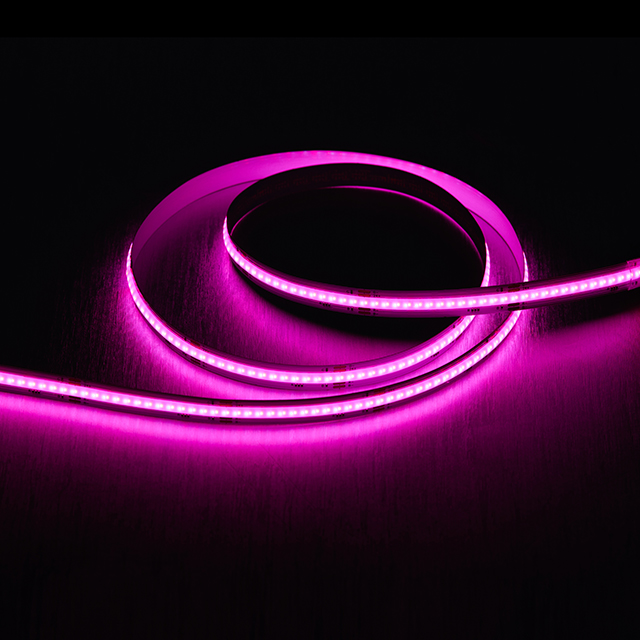Views: 0 Author: Site Editor Publish Time: 2025-05-22 Origin: Site
Are you considering LED light strips for your next project? With so many types available, choosing the right one can be tricky. LED light strips are versatile, energy-efficient, and easy to install. Unlike traditional lighting, they offer flexibility in both installation and design.In this article, you'll learn about the different types of LED strips, their characteristics, and how to choose the best one for your needs.
Choosing the right LED strip for your project can make all the difference. Understanding the types available helps you avoid common mistakes and make a more informed decision. Here's why it matters:
The right LED strip ensures better performance and longer lifespan. For example, using a high-density strip in a large room guarantees even lighting. Waterproof strips are perfect for outdoor areas, while color-changing ones bring vibrant effects for special events. Picking the right type ensures your lighting project looks great and lasts longer.
Every project has different needs. For subtle, ambient lighting in your kitchen, go for a tunable white strip. If you're lighting a gaming setup or a party, RGB or addressable LED strips will give you the dynamic color effects you need. Picking the wrong type could leave your project underwhelming or inefficient.
Many people choose LED strips based on price alone. However, cheap options might cut corners, leading to poor quality and early failures. Watch out for low-quality strips lacking important features like good color rendering or proper heat dissipation. To get the most out of your investment, always check the specs.
There are many types of LED strip lights. Each has unique features, benefits, and best-use scenarios. Let's break down the most common ones so you can find what works for your project.
These chips are mounted directly on the strip's surface. They're small but powerful.Popular Types:
Chip Type | Size (mm) | Brightness | Notes |
2835 | 2.8 × 3.5 | High | Very efficient and bright |
3528 | 3.5 × 2.8 | Low | Good for soft accents |
5050 | 5.0 × 5.0 | Medium | Can support RGB color |
Pros:
● Available in many brightness levels
● Budget-friendly
Cons:
● Some types have visible LED dots
● Light may not be uniform
What makes COB different?
COB strips use tightly packed LEDs covered by a yellow phosphor layer. They shine as one smooth line.Why it's great:
● No visible hot spots
● Smooth, dot-free glow
● Best used on shiny surfaces like glass or metal
Color Options:
● White (warm, cool, or neutral)
● Red, Green, Blue, Amber
Best for:
● Accent lighting
● Task lighting in kitchens or workspaces
● Clean, consistent color tone
What they do:
Change from warm (2700K) to cool (6500K) white light.Perfect for:
● Living spaces
● Mood lighting
● Anywhere you want control over light temperature
What's special?
Mix red, green, and blue to make millions of colors.Use them for:
● Gaming setups
● Party decor
● Backlighting for TVs or monitors
Why it's better than RGB:
They include a dedicated white LED. This gives better clarity and more natural white tones.Benefits:
● Brighter whites
● More control over lighting effects
● Ideal for multipurpose spaces
What makes them cool?
Each LED (or group) can be individually controlled using a chip like WS2812B or SK6812.Great for:
● Light shows
● Animations
● Holiday displays
Note:
Requires special controllers like Arduino or WLED-based systems.
How they work:
They plug directly into an AC outlet. No separate power supply needed.Used in:
● Large commercial spaces
● Outdoor signs
● Long continuous runs
Reminder:
Not as flexible or safe for DIY home use.
IP Ratings Explained:
Rating | Protection Level |
IP65 | Water-resistant |
IP67 | Splash + temporary submersion |
IP68 | Fully waterproof |
Install them:
● Around pools
● Garden paths
● Outdoor kitchens or gazebos
What's unique?
More than one row of LEDs on a wider strip.
Advantages:
● Stronger, wider light output
● Better for signs and big spaces
How they work:
Light shines from the side, not the top.Use them:
● In slim spaces
● For edge lighting
● Behind glass or acrylic edges
Use this list to compare strip types quickly:
LED Strip Type | Best For | Special Features |
SMD | General lighting | Many chip types and densities |
COB | Smooth, even lighting | No visible dots |
Monochrome | Clean, single-color lighting | Simple setup |
Tunable White | Adjustable mood lighting | Control over color temperature |
RGB | Decorative and fun | Color-changing effects |
RGBW / RGBCCT | Mixed-use and clean white output | Extra clarity and flexibility |
Addressable | Shows, effects, animation | Pixel-level control |
High Voltage (AC) | Commercial long runs | Plug-and-play |
Outdoor Waterproof | Exterior use | Protected against water and dust |
Multi-Row | Bright, wide-area coverage | Multiple LED rows |
Side-Emitting | Tight or edge spaces | Light from the side |

Not all LED strips fit into just one type. We can also group them based on how they perform or where they're used. Below are other smart ways to look at LED strip lights.
LED strips don't just shine white—they come in many forms.
● Static White:
● Only one color temperature. It's steady and reliable. Available in warm, neutral, or cool white.RGB:
● Mixes red, green, and blue to create a rainbow of colors. You control it using a remote or app.RGBW:
● Like RGB, but with an added white LED. That means clearer whites and better color blending.Tunable White:
● Lets you shift between warm yellowish light (2700K) and cool bluish white (6500K).UV and Infrared:
Useful for special effects, inspections, or sensors. UV glows; IR works invisibly.
LED strip voltage affects brightness, distance, and safety.
Voltage | Common Use | Max Run Length |
5V | Digital/pixel addressable projects | Short (best under 1–2m) |
12V | DIY home projects | Up to 5m |
24V | Long installations/commercial | Up to 10m or more |
36V | Industrial tasks | Even longer runs |
48V | Professional setups | Very long distances |
● Tip:
For fewer voltage drops, pick 24V or higher if your run is long.
How close the LEDs are affects brightness and smoothness.
Density Level | LEDs per Meter | Light Appearance |
Low | ≤ 60 | Spaced-out, visible dots |
Medium | 60–120 | Balanced brightness |
High | ≥ 120 | Smooth, even glow |
● Use COB strips for a completely dotless look.
● Higher density means more power draw—but also more light.
IP stands for Ingress Protection. It shows how safe the strip is from dust or water.
IP Rating | Protection Level | Where to Use |
IP20 | No water protection | Indoors, dry areas |
IP65 | Splash-resistant | Kitchen, bathroom edges |
IP67 | Temporary submersion safe | Outdoor, garden lighting |
IP68 | Fully submersible | Pools, fountains |
● Higher IP = more protection.
● Make sure your connectors match the strip's rating.
Brightness is measured in lumens. CRI tells how true colors look under the light.
Want colors to look real on camera? High TLCI strips are best for video work.
Application | Suggested Brightness (Lumens/Ft) | CRI Recommendation |
Mood lighting | 150–350 | CRI 80+ |
Under-cabinet lights | 300–500 | CRI 90+ |
Photography/video | 500–700 | CRI 95+ / TLCI 90+ |
Not all LED strips are the same. Picking the right one depends on what you need, where you'll install it, and how it will look. Let's break it down so your next lighting project goes smoothly.
● For indoor spaces, IP20 or IP33 rated strips work well.
● Use IP65+, IP67, or IP68 strips for areas exposed to moisture, like patios or bathrooms.
Location | Suggested IP Rating | Notes |
Bedroom | IP20 | Dry, safe environment |
Kitchen | IP65 | Handles light splashes |
Backyard deck | IP67 | Rain-proof and durable |
Pool area | IP68 | Safe for full submersion |
● Functional lighting means brighter output. Think task lighting under cabinets.
● Decorative lighting focuses on ambiance. RGB or color-changing strips work great.
Need bright light for work? Go for 450+ lumens/foot.
Think about how you'll attach the strip.
● Peel-and-stick adhesive: Quick, but works best on smooth surfaces.
● Mounting clips: Great for rough or vertical installs.
● Aluminum channels: Offer a clean, professional look and help with heat dissipation.
● Type: Static White or Tunable White
● Specs: 3000K–4000K, high CRI, 12V or 24V
● Mounting: Aluminum channels with frosted covers
Use dimmable options for day-to-night transitions.
● Type: RGB or Addressable (Digital)
● Specs: Choose 5050 or pixel-controlled strips like WS2812B
● Control: Sync with music or use app control
Feature | RGB Strip | Addressable Strip |
Static colors | Yes | Yes |
Individual control | No | Yes (per pixel) |
Cool effects | Basic | Complex animations |
● Type: Waterproof RGB or White
● Specs: IP67 minimum, 24V for longer runs
● Location Ideas: Decks, walkways, garden edges, fences
Always seal ends and connectors for added weather protection.
● Type: High-CRI White or Tunable White
● Specs: CRI 95+, flicker-free, 5600K (daylight) or 3200K (warm)
● Mounting: Use diffusers to reduce harsh shadows
Application | Suggested CRI | CCT Range |
Product shooting | 95+ | 5000–5600K |
Portraits | 90+ | 3200–5000K |
YouTube videos | 90+ | Variable (CCT) |
Let your project guide your choice—match function, form, and space to the right LED strip.

There are many types of LED Light Strips—SMD, COB, RGB, tunable white, and more.
Start by thinking about where and how you'll use the light. Match the strip to your needs: brightness, color, or location.
If you're new to LED strips, start with simple kits. Look for clear specs like lumens and IP ratings.
Not sure what to choose? Ask a lighting expert. They'll help you avoid costly mistakes.
A: Yes. Cut along marked copper pads using scissors. Use solder or clip-on connectors to extend or join segments.
A: Yes, if they're waterproof. Look for IP65, IP67, or IP68 ratings. Use sealed connectors and weatherproofing accessories.
A: RGB strips can create millions of colors. RGBW adds true white. RGBCCT adds adjustable white temperature.
A: RGB changes whole-strip color. Addressable strips control each LED individually for animations and effects.
A: Yes, most need controllers. RGB, tunable white, and addressable strips require specific controllers for full functionality.
INTEGRATE™ is a series of integrate flexible LED strips including single White, single Color, variable white, RGB, RGB pixel, RGBW and RGBVW. Various types would meet any your customized requirements. Integrate has dome surface as COB for soft and dot-less effect, same SMD technology as lighting sou
Light and color have long been understood to influence human emotions, behavior, and even physical well-being. From the moment we wake up to the time we go to sleep, the type of light surrounding us plays a vital role in shaping our moods, productivity, and overall state of mind. This is why understanding the psychology of light and color is crucial when selecting LED lighting for various environments, whether it's at home, in the office, or in commercial settings.
LED strip lights are a popular choice for modern lighting due to their energy efficiency, versatility, and sleek design. However, one crucial aspect that is often overlooked when using LED strips is thermal management. LED lights, like any other electronic component, generate heat as they operate, and if not properly managed, this heat can reduce their performance and lifespan.
Choosing the right LED strip lights for your home or office is a decision that requires careful consideration. LED strips have become an increasingly popular choice due to their versatility, energy efficiency, and aesthetic appeal. However, with so many options available on the market, it’s easy to feel overwhelmed by the number of different types and features.
Indirect lighting has become a popular choice for creating a soothing and stylish ambiance in both residential and commercial spaces. Unlike direct lighting, which often creates harsh shadows and bright spots, indirect lighting provides a more gentle and even illumination that enhances the atmosphere without overwhelming the eyes.
Proper lighting on boats or yachts is not just about enhancing the aesthetic appeal; it plays a crucial role in ensuring safety, functionality, and comfort on the water. Effective lighting can help improve visibility during nighttime navigation, set the mood for evening activities, and highlight specific areas of your vessel. One of the best lighting options for marine environments is LED strip lights. Their versatility, energy efficiency, and durability make them an excellent choice for a variety of marine applications.
To ensure that your LED strip lights continue to perform at their best and last as long as possible, proper care and installation are essential. LED strips are known for their longevity and energy efficiency, but several factors can influence how long they last. By following some simple yet effective maintenance tips, you can extend the lifespan of your LED strips and keep them running smoothly for years to come.
When purchasing LED strip lights for your home or business, you might notice various certifications listed on the product packaging or technical specifications. These certifications, often represented by logos or marks, indicate that the product has met specific safety, environmental, and quality standards. Understanding what these certifications mean can help you make informed decisions, ensuring you choose a reliable and safe lighting solution.
LED strip lights are a fantastic way to add vibrant lighting to your home or workspace, offering versatility and energy efficiency. However, when it comes to installation, there are common mistakes that many people make, which can negatively affect the performance, lifespan, and overall functionality of the LED strips. Whether you're a seasoned DIYer or a first-time installer, it's crucial to avoid these common errors to ensure your LED lights shine brightly and last for years to come.
Flexible lighting strips, commonly known as LED strips or tape lights, have revolutionized the way we illuminate spaces. Their adaptability, energy efficiency, and vibrant lighting options make them popular choices for a wide variety of applications—from home decor to commercial advertising and industrial uses.
In recent years, flexible lighting strips have become increasingly popular not just for indoor use, but also as a creative and practical solution for outdoor lighting applications.
Flexible LED strip lights have rapidly gained popularity in both residential and commercial lighting applications. Their versatility, energy efficiency, and ease of installation make them an excellent choice for accent lighting, decorative purposes, and practical illumination alike.
Flexible lighting strips, commonly known as LED strip lights, are thin, versatile lighting fixtures that consist of small light-emitting diodes (LEDs) mounted on a flexible circuit board.
In the world of modern lighting, flexible lighting strips—also known as LED strip lights or ribbon lights—have revolutionized how we illuminate spaces. These thin, adaptable lighting solutions offer not only energy efficiency but also unmatched versatility, making them a top choice for a wide range of residential, commercial, and industrial applications.
Are you looking to enhance your space with vibrant lighting? LED Neon Flex is an energy-efficient, versatile, and durable solution that mimics traditional neon lights.
In the ever-evolving world of lighting, RGB Neon Flex Strip Light has emerged as a game-changer, offering a flexible, energy-efficient, and highly customizable alternative to traditional neon lighting.
Looking for a way to brighten up your space with vibrant lighting? Neon flex strip lights are a fantastic solution.
Have you ever wondered if you can cut neon flex strip light? This versatile lighting solution has become increasingly popular for custom projects.
COB LED strips are becoming an increasingly popular lighting solution, offering exceptional quality and performance.
Ever seen your wall paint or clothes look weird under certain lights? That's probably a low CRI at work. CRI affects how true colors look. It can make your home feel bright or dull. In this post, you'll learn what CRI means, why it matters, and which CRI is best for LED strips.


